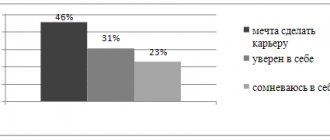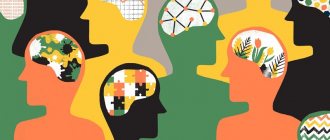One of the features that distinguishes a person from an animal is his ability, when coming into contact with the world around him, to observe, influence it, transform and create something new.
Moreover, often a person acts not limited by the framework of reality, but guided by his imaginary ideas. We will consider the mechanisms of imagination in psychology in this article.
The Essence of Imagination
What is imagination
Every image reproduced by a person is the embodiment of a modified reality.
Imagination is the process of creating new images by transforming ideas obtained in the surrounding reality.
When a person creates something new, he has in his mind an image that does not exist in reality, built thanks to his experience.
Imagination is closely related to memory, thinking and perception. Thanks to the connection between thinking and imagination, it is possible to get out of difficult life situations and solve problems with uncertain conditions.
If it is necessary to reproduce situations from past experience, then a person finds in his memory certain images that he had previously stored.
The perception of life would not be so bright and emotional without the participation of imagination. Throughout human evolution, the process of creating images has been involved not only in the development of work, but also in dreams and plans.
Types of imagination
Imagination can be intentional or unintentional.
Like memory processes, imagination processes are divided according to the degree of volitional effort into intentional and unintentional.
The unintentional work of the imagination takes place in daydreams, dreams, or half-asleep states.
Images are created spontaneously and in unusual combinations.
This is a passive process, independent of a person’s desires, in which his unmet needs are often embodied.
Intentional imagination is the deliberate process of creating specific images by a person of his own free will. He himself controls and directs his ideas depending on the situation, realizing the purpose and motives of his actions.
Arbitrary imagination has such forms as recreating (reproduction of an image according to its characteristics) and creative imagination (embodiment of a new image through one’s own conjecture).
Recreating imagination works when, having a specific description of an object, a person imagines its full image. For example, when reading fiction, a mental image of the characters or events described is formed.
Creative imagination is the creation of a new image through additions and transformations of an existing one. This kind of imagination is the basis of art.
In the process of creativity, active imagination mainly works, and the conscious formation of an image occurs. The Creator allows you to look at the world from a different perspective, using your means of expression.
Dreams and conscious creativity of a person as manifestations of human imagination
Dreams and conscious creativity are also the fruits of human imagination. At the moment when a person, without setting a specific goal for himself, without thinking about the content of a new idea, goes into the world of images and phenomena that arise in him, then precisely, this is daydreaming, in the process of which the imagination actively participates.
Finished works on a similar topic
Coursework Activity of the imagination 470 ₽ Abstract Activity of the imagination 220 ₽ Examination Activities of the imagination 230 ₽
Receive completed work or specialist advice on your educational project Find out the cost
By the same principle, conscious human creativity is also possible.
He sets himself a specific goal, ponders a specific idea and uses the images that arise in him in the process of comprehending the upcoming activity. It is here that fantasies and the activity of a person’s conscious creativity come into play.
Note 2
Thus, we can conclude that daydreaming coincides with manifestations of passive imagination, and conscious creativity and fantasy coincide with active manifestations of imagination.
Physiological basis
Combinations of neural connections are formed at conscious and unconscious levels
Physiological processes responsible for the functioning of the imagination regulate the vital processes of the body.
Complex processes occur in the brain, during which nerve connections are activated and redistributed.
As a result of these processes, new neural combinations appear, which are the basis of the physiology of imagination.
Combinations of nerve connections are formed:
- at the unconscious level: from a spontaneous reaction in the cerebral cortex to various stimuli (for example, sleep or hallucinations);
- on a conscious level: in the process of a person’s independent creation of new images, several parts of the brain work (in all voluntary types of imagination).
The formation of new connections is not a random process; it can be described as the creative work of the brain.
Imagination influences many physiological processes: the functioning of organs, the level of activity of glands, metabolic processes. For example, when a person imagines a tasty dish, he salivates more.
When thinking about intense physical activity, you may notice subtle muscle activity. Consequently, imagination is closely related to human life processes and behavior.
Functions of the imagination
Sometimes imagination serves a protective function
The human brain cannot remain inactive for long, so people indulge in dreams.
For the imagination to work, it is not necessary to have new information or solve any problems.
It is known that it is very difficult for a person to stop the imagination and stop thinking at will.
During life, the human imagination performs many functions, the main of which are:
- regulatory – planning the future, presenting ways to achieve goals, regulating and programming activities and their results;
- cognitive – getting to know the world around you through concentration of attention, memory and thinking, activated by imagination;
- adaptive – presentation of complex phenomena and images through simpler ones;
- psychotherapeutic – creating psychological protection;
- affective – changing the emotional state, relieving tension.
Using his imagination, a person controls the processes occurring in the body, and also adapts to various situations. It is known that thanks to imagination you can change your heart rate, blood pressure and body temperature.
The role of imagination in human life
A good imagination is a necessary quality for success.
Unlike animals, man, with his ability to imagine, acts in the future, planning the future.
Imagination stimulates a person to action, forces him to go through a complex, multi-stage path, and encourages him to believe in the result of his work.
But, from another point of view, a dreamer satisfies his needs mentally, refusing real efforts.
Such a negative factor reduces a person’s activity, turning imagination against reality.
Fantasy plays a big role in the production of new inventions. Any modern, familiar object was a figment of human imagination hundreds of years ago.
Through imagination and hard work, new advances are constantly introduced into people's lives. A developed imagination is an essential ability of a successful person.
Theses
- Imagination is a manifestation of a person’s fantasy;
- Imagination is the degree of development of the inner world of a person;
- Imagination is a creative gift that determines the possibilities for creation;
- Imagination is the ability to create your own version of the world around you;
- Imagination is the ability to creatively perceive reality;
- Imagination is the ability to individually transform reality;
- Imagination is the ability to see how the life of the inner world of a person flows;
- “Imagination is the most important thing, it is a reflection of what we attract into our lives” A. Einstein;
- “Logic will take you from point A to point B. Imagination will take you anywhere.” A. Einstein;
- “Everything you can imagine is real” P. Picasso.
Stages of imagination development
Imagination is not an innate quality, and it can be developed
However, imagination is not an innate quality.
Its development occurs gradually, in the course of obtaining certain ideas that serve as the foundation for the creation of new images.
The development of imagination is promoted by personal self-improvement, education, training of memory, thinking and feelings.
It is difficult to limit the stages of imagination development by age category, since it depends on individual characteristics.
Based on some regularities, we can say that for the first time imagination is realized through perception. For example, it is difficult for a small child to imagine the plot of a fairy tale, but it is easier for him to imagine the situation happening to himself.
The connection between imagination and perception also manifests itself when the child transfers the received ideas into his games, mentally changing the appearance of objects. The work of imagination in childhood is always associated with activity, in this case – play.
At the stage when a child learns to speak, he begins to form not only images, but also more complex ideas. He has to find words to express what exists in his imagination.
It becomes easier for the child to separate the characteristics of an object from itself and use them to express other ideas. Images spontaneously arise and are combined in a child’s imagination.
At the next stage of imagination, the child can already deliberately recreate images. He begins to control his imagination during games and creative activities, imagining a goal or plot.
At the onset of school age, imagination rises one more level. Making efforts to complete learning tasks, the child actively recreates images and uses existing ideas.
Mechanisms for creating images
Without imagination there would be no books and films
The images that arise in the imagination do not appear out of nowhere. They proceed from received ideas about real phenomena and objects.
Life impressions are combined in a person’s imagination, taking on various forms.
Imagination processes are divided into two levels:
- Analysis of impressions.
- Synthesis of the resulting images.
At the first level, ideas about an object are abstracted from other images, their components are separated, and analysis occurs. Subsequently, these images are transformed: combined into different combinations or reincarnated into completely new ideas.
This synthesizing process takes many forms. Agglutination is one of the common forms of synthesis, during which a new image is created by transferring the characteristics of one object to another.
In this way, images of ancient gods and mythical creatures were created in the imagination. The technique of agglutination is widely used in art and other creative processes.
For example, in order to draw a non-existent animal, it combined the features of various famous animals and birds. With the help of agglutination, parts of an object or the entire object are increased or decreased. This is how fairytale giants and gnomes were created.
By introducing existing ideas into new situations, new connections with completely different meanings are obtained. A person achieves correspondences in this combination by imagining the goal and controlling the process.
The synthesis of ideas is carried out through schematization and emphasis. Schematicization occurs as a result of insufficiently complete perception of the object. As a result, the holistic image may be distorted and inconsistent with reality.
Also, schematization can manifest itself when forgetting some properties of an object and representing it in a more generalized way. A person can consciously or unconsciously highlight certain features in an image.
Emphasis lies in focusing attention on the main properties of the image and creating a typical idea of the subject. In this complex creative process of generalization, a person identifies the main, in his opinion, features in the image and reflects reality through his own prism.
Example from life
I enjoy reading. Imagination helps you immerse yourself in the story. Even seemingly tedious descriptions of the area become much more interesting. I try to see the landscape through the eyes of the author, hear sounds, feel the wind or the scent of flowers.
The same goes for heroes. I try to imagine not only their appearance, but to monitor how their behavior and thinking changes in different situations. Thanks to this, after reading the book, it seems that I have visited this book world.
Individual characteristics of imagination development
Each person has a different degree of development of imagination, which is reflected in his activities and relationships in society. The individuality of people is that they differ in their own vision of the world.
The brightness of ideas and the novelty of transformed ideas depend on the degree of development of imagination. A strong imagination is an integral feature of artists, writers, sculptors, and directors.
It is difficult for a person with weak imagination to solve problems related to the mental design and representation of specific objects. An insufficiently developed imagination makes life less vibrant and emotional.
People differ significantly in the dominant types of imagination: visual, auditory, kinesthetic. But it happens that a person has highly developed all types, which is reflected in his character and behavior.
In this video you will learn about the psychology of imagination:
The more developed our imagination is, the better we can imagine the world around us. It helps us color our gray everyday life and imagine our future in colors. From a psychological point of view, imagination helps a person work on himself and his thoughts. Any problem becomes easily solvable if we use our imagination. Looking at the problem from above, it does not seem too difficult, the main thing is to understand where to start solving it.
Imagination in psychology
By using your imagination, you can imagine a particular situation from a different angle, thus forming a more comprehensive opinion. After all, sometimes we get in the way of emotions that cloud our reason and prevent us from making the right decision. All the answers to any questions are in our head; we just need to abstract ourselves from the problem and give ourselves time to think about it thoroughly. If you imagine yourself in the place of another person and try to understand his thoughts, you can have a different attitude towards the misunderstanding that has arisen between you. For example, in a quarrel we often draw the wrong conclusions and get offended by our loved one, but if we imagine ourselves in the place of a man, we can conclude that he does not always act wrongly out of malice. A man’s logic and train of thought are very different, so you must definitely put yourself in his place before you are offended by his actions.
Negative thoughts
How else can imagination help and why is imagination such an important aspect in psychology? In a relationship, in order for it not to become insipid, the work of two people is necessary. A woman is more able to control the emotional background in a couple because she has a more developed imagination. If a man does not want to change and become better, a woman has the power to change herself, which has a positive effect not only on relationships, but also on her psyche. By turning on the imagination, it can change as often as required, be different every day, adapt to situations.
When a dark streak comes in life and many problems appear that cannot be solved in an instant, it is imagination that helps to maintain a positive attitude, because we can always imagine something good and distract ourselves from bad thoughts. It’s always better to dream, even about something unrealistic for now, than to plunge into bad memories. Therefore, if you are drawn to remember some sad event from your past, drive away these thoughts and imagine only a positive future. After all, what we imagine often appears in our lives, just a little later than we would like.
Setting Goals
In order for your dreams to become a reality, you need to start taking action, gradually approaching the goal you want to achieve. You shouldn’t idealize people and situations too much; it doesn’t hurt to look at things with a certain amount of cynicism. Also, don’t lose faith that your dream will come true, because if you believe strongly in something, it becomes a reality! But you should only dream about what you can achieve yourself, and not about the actions of another person. It is unrealistic to influence the actions of other people with the power of thought, but setting yourself up for a positive outcome is easy! And therefore imagination in psychology is especially valued by specialists.
What we cannot do without and imagine our thoughts is imagination. In psychology, the technique of substitution is often used, when bad thoughts are blocked by good ones, which helps to cope with an unpleasant situation. By learning to manage your thoughts, you can make your life more joyful and less susceptible to emotions. Learn to think positively, and then long-awaited changes will begin to happen in your life!










